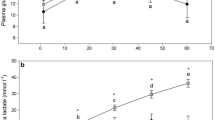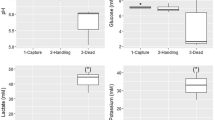Abstract
Stress from fishing capture can incite potentially lethal physiological changes in fishes. Blood acid–base status has routinely been utilized to gauge the magnitude of the stress response, which is dependent on the nature of the capture event and metabolic capacity of the species in question. The mortality induced by demersal longline capture has been shown to vary among taxonomically similar carcharhinid elasmobranchs. In this study, we aimed to: (1) quantify and compare blood acid–base disturbances associated with longline capture in five carcharhinid species; (2) examine the extent to which these disturbances correspond with reported at-vessel mortality rates; and (3) investigate how interspecific differences in the physiological stress response could relate to life history, ecology, and phylogeny. Results showed that blood acid–base disturbances from longline-capture varied between species, with relative degrees of disturbance by species proportional to previously reported at-vessel mortality rates. In addition, the degree in which metabolic and respiratory acidoses influenced relative depressions in blood pH also differed by species. The differences in blood acid–base status point to discrepancies in the aerobic and anaerobic capacities among these taxonomically similar species, and are important when considering the effects of, and possible means to mitigate deleterious consequences from, longline fishing capture.
Similar content being viewed by others
Notes
This study was selected on the basis that pK′ and αCO2 values were presented for temperatures (10, 15, and 20ºC) corresponding with those in the present study. Additional studies on elasmobranchs present alternative experimentally derived, though slightly divergent, values for pK′ and αCO2 (e.g. Albers and Pleschka 1967; Pleschka and Wittenbrock 1971; Boutilier et al. 1984; and see Weber et al. 1983). It should be noted that the variability in these constants when comparing fish, reptiles and mammals is quite small, where if used interchangeably in the Henderson–Hasselbalch equation at a given temperature and pH, will not yield considerable differences in HCO3 −.
The low end of the readable range for lactate differs on the i-STAT (0.3 mmol l−1) and Lactate Pro (0.8 mmol l−1). Thus, concluding a close correspondence in side-by-side values for this parameter between the two instruments (on control dogfish spp) assumed that i-STAT lactate values (mean value of 0.42 mmol l−1) were closely aligned with corresponding Lactate Pro values, although values of the latter read as “<0.8 mmol l−1”.
References
Adams SM (1990) Biological indicators of stress in fish. Bethesda, American Fisheries Society, Symposium 8:191
Albers C, Pleschka K (1967) Effect of temperature on CO2 transport in elasmobranch blood. Respir Physiol 2:261–273
Ashwood ER, Kost G, Kenny M (1983) Temperature correction of blood-gas and pH measurements. Clin Chem 29:1877–1885
Berkeley SA, Irby EW Jr, Jolley JW Jr (1981) Florida’s commercial swordfish fishery: longline gear and methods. Florida Sea Grant Cooperative Extension Service MAP-14, Miami, p 23
Bernal D, Dickson KA, Shadwick RE, Graham JB (2001) Analysis of the evolutionary convergence for high performance swimming in lamnid sharks and tunas. Comp Biochem Physiol 129A:695–726
Bernal D, Sepulveda C, Mathieu-Costello O, Graham JB (2003a) Comparative studies of high performance swimming in sharks I. Red muscle morphometrics, vascularization and ultrastructure. J Exp Biol 206:2831–2843
Bernal D, Smith D, Lopez G, Weitz D, Grimminger TADK, Graham JB (2003b) Comparative studies of high performance swimming in sharks II. Metabolic biochemistry of locomotor and myocardial muscle in endothermic and ectothermic sharks. J Exp Biol 206:2845–2857
Boutilier RG, Heming TA, Iwama GA (1984) Physiochemical parameters for use in fish respiratory physiology. In: Hoar WS, Randall DJ (eds) Fish physiology, vol XA. Academic Press, New York, pp 403–430
Brill R, Bushnell P, Schroff S, Seifert R, Galvin M (2008) Effects of anaerobic exercise accompanying catch-and-release fishing on blood-oxygen affinity of the sandbar shark (Carcharhinus plumbeus, Nardo). J Exp Mar Biol Ecol 354:132–143
Bushnell PG, Brill RW (1992) Oxygen transport and cardiovascular responses in skipjack tuna (Katsuwonus pelamis) and yellowfin tuna (Thunnus albacares) exposed to acute hypoxia. J Comp Physiol B 162:131–143
Carlson JK, Goldman KJ, Lowe CG (2004) Metabolism, energetic demand, and endothermy. In: Carrier JC, Musick JA, Heithaus MR (eds) Biology of sharks and their relatives. CRC Press, Boca Raton, pp 203–224
Claiborne JB (1998) Acid–base regulation. In: Evans DH (ed) The physiology of fishes, 2nd edn. CRC Press, Boca Raton, pp 177–198
Cliff G, Thurman GD (1984) Pathological effects of stress during capture and transport in the juvenile dusky shark, Carcharhinus obscurus. Comp Biochem Physiol A 78:167–173
Cooper AR, Morris S (1998) The blood respiratory, haematological, acid–base and ionic status of the Port Jackson shark, Heterodontus portusjacksoni, during recovery from anaesthesia and surgery: a comparison with sampling by direct caudal puncture. Comp Biochem Physiol A 119:895–903
Davis MW (2002) Key principles for understanding fish bycatch discard mortality. Can J Fish Aquat Sci 59:1834–1843
Dickson KA (1996) Locomotor muscle of high performance fishes: what do comparisons of tunas with other ectothermic taxa reveal? Comp Biochem Physiol A113:39–49
Dickson KA, Gregorio MO, Gruber SJ, Loefler KL, Tran M, Terrell C (1993) Biochemical indices of aerobic and anaerobic capacity in the muscle tissues of California elasmobranch fishes differing in typical activity level. Mar Biol 117:185–193
Heisler N (1988) Acid–base regulation. In: Shuttleworth TJ (ed) Physiology of elasmobranch fishes. Springer, Berlin, pp 215–252
Heisler N, Neumann P (1980) The role of physico-chemical buffering and of bicarbonate transfer processes in intracellular pH regulation in response to changes of temperature in the larger spotted dogfish (Scyliorhinus stellaris). J Exp Biol 85:99–110
Heisler N, Neumann P, Holeton GF (1980) Mechanisms of acid–base adjustment in dogfish (Scyliorhinus stellaris) subjected to long-term temperature acclimation. J Exp Biol 85:89–98
Hoffmayer ER, Parsons GR (2001) The physiological response to capture and handling stress in the Atlantic sharpnose shark, Rhizoprionodon terraenovae. Fish Physiol Biochem 25:277–285
Holeton GF, Heisler N (1978) Acid–base regulation by bicarbonate exchange in the gills after exhausting activity in the larger spotted dogfish, Scyliorhinus stellaris. Physiologist 21:56
Holeton GF, Heisler N (1983) Contribution of net ion transfer mechanisms to acid–base regulation after exhausting activity in the larger spotted dogfish (Scyliorhinus stellaris). J Exp Biol 103:31–46
Iwama GK, McGeer JC, Pawluk MP (1989) The effects of five fish anaesthetics on acid–base balance, hematocrit, blood gases, cortisol, and adrenaline in rainbow trout. Can J Zool 67:2065–2072
Jensen FB, Nikinmaa M, Weber RE (1983) Effects of exercise on acid–base balance and respiratory function in blood of the teleost Tinca tinca. Respir Physiol 51:291–301
Kieffer JD (2000) Limits to exhaustive exercise in fish. Comp Biochem Physiol 126A:161–179
Kieffer JD, Rossiter AM, Kieffer CA, Davidson K, Tufts BL (2002) Physiology and survival of Atlantic salmon following exhaustive exercise in hard and soft water: implications for the catch and release sportfishery. N Am J Fish Manage 22:132–144
Lai CN, Graham JB, Burnett L (1990) Blood respiratory properties and the effect of swimming on blood gas transport in the leopard shark Triakis semifasciata. J Exp Biol 151:161–173
Lau J, Ioannidis JPA, Schmid CH (1997) Quantitative synthesis in systematic reviews. Ann Intern Med 127:820–826
Mandelman JW, Farrington MA (2007a) The physiological status and mortality associated with otter-trawl capture, transport, and captivity in an exploited elasmobranch, Squalus acanthias. ICES J Mar Sci 64:122–130
Mandelman JW, Farrington MA (2007b) The estimated short-term discard mortality of a trawled elasmobranch, the spiny dogfish (Squalus acanthias). Fish Res 83:238–245
Manire C, Heuter R, Hull E, Spieler R (2001) Serological changes associated with gillnet capture and restraint in three species of sharks. Trans Am Fish Soc 130:1038–1048
Milligan CL (1996) Metabolic recovery from exhaustive exercise in rainbow trout. Comp Biochem Physiol 113A:51–60
Morgan A, Burgess GH (2007) At-vessel fishing mortality for six species of sharks caught in the Northwest Atlantic and Gulf of Mexico. Gulf Carib Res 19:123–129
National Marine Fisheries Service (NMFS) (2006) Final Consolidated Atlantic Highly Migratory Species Fishery Management Plan. NOAA, NMFS, Office of Sustainable Fisheries, Highly Migratory Species Management Division, pp 1600
Nunn JF, Bergman NA, Bunatyan A, Coleman AJ (1965) Temperature coefficients for \({{\rm PCO}_{2}}, {{\rm PO}_{2}}\) of blood in vitro. J Appl Physiol 20:23–26
Pickering AD (1981) Stress and fish. Academic Press, New York, p 367
Piiper J, Meyer M, Drees F (1972) Hydrogen ion balance in the elasmobranch, Scyliorhinus stellaris, after exhausting activity. Respir Physiol 16:290–303
Pleschka K, Wittenbrock I (1971) The solubility of carbon dioxide in elasmobranch plasma between 10°C and 22°C. Pflügers Arch 329:186–190
Randall DJ, Heisler N, Drees F (1976) Ventilatory response to hypercapnia in the larger spotted dogfish Scyliorhinus stellaris. Am J Physiol 230:590–594
Reeves RB (1977) The interaction of body temperature and acid–base balance in ectothermic vertebrates. Ann Rev Physiol 39:559–586
Schwalme K, Mackay WC (1985) The influence of exercise-handling stress on blood lactate, acid–base, and plasma glucose status of northern pike (Esox lucius L.). Can J Zool 63:1125–1129
Skomal G (2006) The physiological effects of capture stress on post-release survivorship of sharks, tunas, and marlin. Ph.D. dissertation, Boston University, pp 304
Skomal G (2007) Evaluating the physiological and physical consequences of capture on post-release survivorship in large pelagic fishes. Fish Manage Ecol 14:81–89
Spargo A (2001) The physiological effects of catch and release angling on the post-release survivorship of juvenile sandbar sharks (Carcharhinus plumbeus). Masters thesis, University of Rhode Island, pp 99
Suski CD, Cooke SJ, Danylchuk AJ, O’Connor CM, Gravel MA, Redpath T, Hanson KC, Gingerich AJ, Murchie KJ, Danylchuk SE, Koppelman JB, Goldberg TL (2007) Physiological disturbance and recovery dynamics of bonefish (Albula vulpes), a tropical marine fish, in response to variable exercise and exposure to air. Comp Biochem Physiol 148A:664–673
Thompson JA, Hughes SG, May EB, and Harrell RM (2002) Effects of catch and release on physiological responses and acute mortality of striped bass. American Fisheries Society, Symposium 30:139–143
Weber RE, Wells RMG, Rossetti JE (1983) Allosteric interactions governing oxygen equilibria in the haemoglobin system of the spiny dogfish, Squalus acanthias. J Exp Biol 103:109–120
Wells RMG, McIntyre RH, Morgan AK, Davie PS (1986) Physiological stress responses in big gamefish after capture: observations on plasma chemistry and blood factors. Comp Biochem Physiol 84A:565–571
Wendelaar Bonga SE (1997) The stress response in fish. Physiol Rev 77:591–625
Wood CM (1991) Acid–base and ion balance, metabolism, and their interactions after exhaustive exercise in fish. J Exp Biol 160:285–308
Wood CM, Turner JD, Graham MS (1983) Why do fish die after severe exercise? J Exp Biol 22:189–201
Acknowledgments
We thank the National Marine Fisheries Service (NMFS) Apex Predators Program for the opportunity to collect data across multiple survey cruises. In particular, L. Natanson and N. Kohler have been instrumental in enabling and abetting our data collection efforts. We would also like to acknowledge fellow scientists, fishermen and crew aboard the R/V Pelican (1996); R/V Delaware II (1998, 2001 and 2007); and R/V Longhorn (2004). In particular, Brad Chase collected samples on several cruises and Heather Marshall collected samples on the 2007 survey cruise. Funding for this work was provided through Federal Aid in Sportfish Restoration to Massachusetts Division of Marine Fisheries, and the New England Aquarium. This is Massachusetts Division of Marine Fisheries Contribution No. 23.
Author information
Authors and Affiliations
Corresponding author
Additional information
Communicated by H. V. Carey.
Rights and permissions
About this article
Cite this article
Mandelman, J.W., Skomal, G.B. Differential sensitivity to capture stress assessed by blood acid–base status in five carcharhinid sharks. J Comp Physiol B 179, 267–277 (2009). https://doi.org/10.1007/s00360-008-0306-4
Received:
Revised:
Accepted:
Published:
Issue Date:
DOI: https://doi.org/10.1007/s00360-008-0306-4




